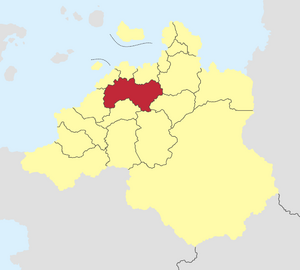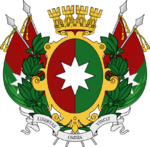Chanchamaya: Difference between revisions
Jump to navigation
Jump to search
mNo edit summary |
mNo edit summary |
||
| Line 12: | Line 12: | ||
| nickname = The {{wp|Bandeirante|Vėliavininkas}} State<br>The Wildflower State<br>The Mineral State | | nickname = The {{wp|Bandeirante|Vėliavininkas}} State<br>The Wildflower State<br>The Mineral State | ||
| motto = ''Audemus iura nostra defendere'' ({{wp|Latin language|Solarian}})<br>(We dare defend our rights) | | motto = ''Audemus iura nostra defendere'' ({{wp|Latin language|Solarian}})<br>(We dare defend our rights) | ||
| image_map = | | image_map = Chanchamaya in Aucuria.png | ||
| mapsize = 300px | | mapsize = 300px | ||
| map_caption = Location of Chanchamaya in Aucuria | | map_caption = Location of Chanchamaya in Aucuria | ||
Revision as of 18:08, 24 March 2022
Chanchamaya
Čančamaja | |
|---|---|
| State of Chanchamaya Čančamajos valstija | |
| Nickname(s): | |
| Motto(s): Audemus iura nostra defendere (Solarian) (We dare defend our rights) | |
 Location of Chanchamaya in Aucuria | |
| Country | |
| Capital | Čačapojas |
| Largest city | Suljanas |
| Government | |
| • Body | Saeimas |
| • Governor | tbd |
| Area | |
| • Total | 66,410.58 km2 (25,641.27 sq mi) |
| • Rank | 7th |
| Population (2014) | |
| • Total | 3,649,056 |
| • Rank | 5th |
| • Density | 55/km2 (140/sq mi) |
| Demonym | Chanchamayan |
| Postal code | ČA |
| ISO 3166 code | AK-CA |
Chanchamaya (Ruttish: Čančamaja) is one of the nineteen states of the Aucurian Republic. Located in central Aucuria, Chanchamaya borders the states of Sidabria, Šventoji Elžbieta, Bendrieji Laukai, Oroncota, Pakrashchia, Chucisaca, Kestutia, and Magdaliete; as a result, it is the Aucurian state with the most neighboring states. The capital of Chancamaya is Čačapojas; the largest city in the state is Suljanas.
[history]
[current economics, demographics, politics, etc.]
History
[any precolonial stuff]
[colonial period]
[postcolonial history]

